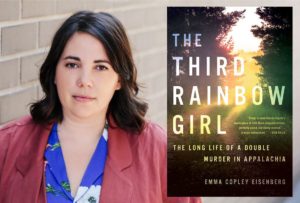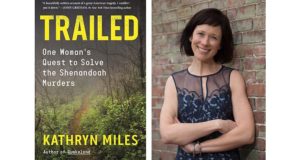After spending half a century reporting on murder, it’s probably not surprising that I don’t read many true crime books for enjoyment and escape. I think it’s because I’ve spent so long covering the dark side so closely, without the reader’s luxury of being able to skip over the truly disturbing details or simply closing the book when it gets to be too much.
True Crime Books: The Third Rainbow Girl and Trailed
But recently, two books—both excellent, engaging reads—gripped me. The Third Rainbow Girl: The Long Life of a Double Murder in Appalachia, by Emma Copley Eisenberg, is set in West Virginia in 1980 and published in 2020. Trailed: One Woman’s Quest to Solve the Shenandoah Murders, by Kathryn Miles, is set in Virginia in 1994 and also just published.

Each deal with an unsolved, cold case murder of young women on or near the Appalachian Trail. More than that, they fall into the rarified category of true crime books that I would call “The Writer as Sleuth.” That is, where the author feels compelled to actively engage with the story – to do rather than simply describe.
The Connection to Met Her on the Mountain
Although well-written and justly praised, these books’ personal pull on me eerily echoes my own 2013 book, Met Her on the Mountain: The Murder of Nancy Morgan, which deals with the unsolved, 1970 kidnap, rape, and murder of a young woman in Western North Carolina, within sight of the Appalachian Trail.
Much separates me from these two authors: They are women and two generations my junior. But like me, they were motivated by an intense, personal connection to the victims, despite not knowing them in life. This link inevitably results in their compelling quest for justice, almost to the point of obsession, to solve these murders.
As writers, we have never met. Still, as I read, I felt a kinship with the authors and found myself rooting for them as they walked a familiar path.
For example, Eisenberg and Miles struggled with their delicate, problematic relationship with law enforcement, who are sometimes cooperative and sometimes not so. Like me, they had to deal with troubling loose ends in each case. The lack of a clear-cut resolution to the murders left them, in the end, to informed speculation.
Confirmation Bias in Trailed
Miles has an interesting section on what investigators call “confirmation bias” – just what I encountered in Met Her on the Mountain. That is, as Miles describes it, the predisposition “to favor any information or opinion that affirms our preconceptions,” once investigators settle on a theory of the case.

As one expert explains to her, “they’ll literally funnel every new piece of evidence through their account of the crime. And if a piece of evidence seems to call that theory into question, they’ll downplay it or even disregard it.”
The expert, Ken Mains, is an ex-cop and founder of the American Investigative Society of Cold Cases. He believes that “new eyes — even amateur eyes— are an important corrective for that kind of bias.”
Miles received a cache of critical materials, including the victims’ journals as well as a notebook from a defense attorney, just as I did, which provided invaluable insights into our cases.
The Classic Narrative Architecture of True Crime
In reading, I could see each author wrestling with the classic narrative architecture of true crime. There are familiar logistical and structural issues inherent in the genre: how much of the story to tease in the preface; when to describe the bodies being found; when to use flashbacks and flash forwards; how much to say about their own motivations in writing the book; how much technical information to include; how much background and context; what to do about an ambiguous resolution; and so on.
The task, then, is to piece all this together in a way that the seams and stitches aren’t obvious to the reader. For both Eisenberg and Miles, their intensely personal, lyrical writing helps cope with these challenges.
Their research process was also familiar to me: sifting through transcripts and old news reports and interviewing family members of survivors, with whom they also felt a kinship, as well as investigators and witnesses. They were always on the lookout for a DNA magic bullet.
Grappling with Doubts
Inevitably, they also grapple with doubts about their ability to solve their cases.
The writers go through similar steps in their investigations: inspecting the crime scene long after the murder; trying to navigate through errors resulting from the confused, conflicting, and sometimes competing law enforcement jurisdictions. On the way, they encounter pitfalls familiar to all true crime writers. Memory is imperfect, especially over time, even of those with nothing to hide or exaggerate.
Miles writes of “the seductive allure of believing you can find answers in a case that has otherwise stumped experts.”
This impulse is understandable, especially on the part of reporters who are veterans of the police beat. As former Los Angeles Times police reporter Michael Connelly put it in his novel Fair Warning, in the voice of fictional former Times reporter Jack MacEvoy: “I knew then that I could no longer be an observer, a journalist who wrote about these things…I knew I could not be a sideline reporter. I needed to be in the game.”
After working the cops and courts beat in the Times’ Orange County Edition, I felt the same way.
Research Process for True Crime Writers
Miles candidly admits to her inability to compartmentalize her emotions while doing the gruesome, if necessary, research.
Forcing herself to view crime scene and autopsy photos, Miles writes, “the reality of criminal investigation has no … filter…[w]hat it depicts leaves an indelible mark on those who are willing to look.”
She adds, “I soon discovered that I was unable to prevent myself from absorbing that anguish and dragging it wherever I went, an invisible weight…I worried I didn’t have the emotional strength and resolve not to let it eat me alive.”
In my case, when researching my new true crime book, Drifting into Darkness: Murder, Madness, Suicide and a Death Under Suspicious Circumstances, the material became so dark that I had to find coping mechanisms. First, I stopped work on the book at eight o’clock each evening.
When that was insufficient, I simply put my murder research aside for several months. Almost as therapy, I wrote a short, much lighter, ebook original, a sequel to my best-selling The Gospel According to the Simpsons: The Spiritual Life of the World’s Most Animated Family, which I called A Newer Testament.
The Feminist Perspective
Another thing that attracted me to the two new books was that the authors brought a strong and welcome feminist perspective to their true crime undertaking.
In writing, Miles says she had been “raging against a culture of intolerance and misogyny that was allowing violence to continue, seemingly unpunished.”
Or, as Eisenberg puts it in The Third Rainbow Girl, in Pocahontas County, West Virginia, where the killings took place, “misogyny is in the groundwater.”
The Writer as Sleuth
In the end, Miles was more successful in dismantling the case against the man law enforcement suspected of the murders than she was in identifying the person she believed was responsible for the killings, much less convincing the authorities. That is a much easier task for the writer, as I well know from both of my books.
“I had far more evidence and key documents than a writer covering a case like this would normally be granted,” Miles writes. “But it still wouldn’t be enough to say who killed” the young women.
She continues, “While I knew none of these conclusions would stand up in court…they at least gave me some solace that I was doing everything I could.”
Of course, that’s the difference between writing a fictional thriller, where the author is both omniscient and omnipotent, tying up all the loose ends and solving the crime, and the true crime writers who, despite their best efforts at sleuthing, can only portray what they find, as messy and sometimes as ambiguous as real life can be.
For information about my upcoming book tour, click here.
Follow me on Facebook, Twitter, and Instagram to learn more. The quickest way to reach me is by email: osopinsky@gmail.com.